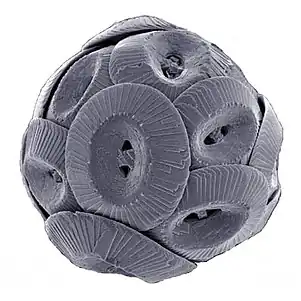Lorica (biology)
| Part of a series related to |
| Biomineralization |
|---|
 |
In biology, a lorica is a shell-like protective outer covering, often reinforced with sand grains and other particles that some protozoans and loriciferan animals secrete.[1] Usually it is tubular or conical in shape, with a loose case that is closed at one end.[2] An example is the protozoan genus Stentor, in which the lorica is trumpet-shaped. In the tintinnids, the lorica is frequently transparent and is used as domicile.[3] Halofolliculina corallasia has a lorica that is attached as an outer structure, and into which it retracts when disturbed.
There are three phases in the formation of lorica: agglomeration in a natural cast; helical extension; and stabilization.[4]
The original meaning of the word is: cuirass, a type of chest armor, originally made of leather, afterward of plates of metal or horn sewed on linen or the like.
See also
- Chitin
- Periostracum
- Tectin
Notes
- ↑ Davis, Charles C. (1 January 1981). "Variations of lorica shape in the genus Ptychocylis (Protozoa: Tintinnina) in relation to species identification". Journal of Plankton Research. 3 (3): 433–443. doi:10.1093/plankt/3.3.433.
- ↑ "lorica (biology) -- Britannica Online Encyclopedia". britannica.com. Retrieved 2009-08-16.
- ↑ "Mic-UK: TINTINNINAE". www.microscopy-uk.org.uk. Retrieved 2009-08-16.
- ↑ Laybourn-Parry, J. A. (31 January 1992). Protozoan plankton ecology – Three phases of lorica formation. ISBN 9780412344404. Retrieved 2009-08-16.